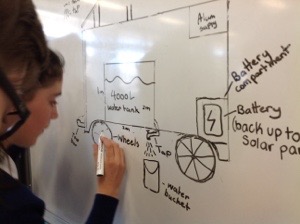Challenge Based Learning seems to turn things around quite a bit. I was thinking this photo of a student in year 7 who was drawing a diagram on the whiteboard in the class room.
It was part of the CBL water project and her group had designed a vehicle that could move through an area and distribute clean water to people who did not have access to water – well clean water anyway. The water was made clean through a chemical process and the vehicles powered through solar panels. The group had found out about a particular place in the world where clean water was not accessible. They had devised a solution to this problem through their research which included finding out how water could be cleaned within a mobile unit and how the vehicle could be powered.
So the thing here is that rather than starting with the scientific knowledge, the student started with the problem – the problem that they were seeking to solve – and by solving the problem or trying to solve the problem they needed to find out about the science that would help to solve the problem.
It seems to me like a way of going about learning where rather than starting with the knowledge and then solving the problem this time they started with a problem and then had to find the knowledge to apply to the problem. How can we clean water in a mobile unit in a remote location? The students were making their own inquiry.
Another thing that this photograph reminds me of was the way that the students were using the classroom space during the sessions. The whiteboard became another surface in the room on which to plan and design, make changes and share. It became a tactile and active recording place and enabled to the group to change things around quite easily. So in this challenge based learning project these two things – and what I mean by this this is firstly the way of starting with a problem and then finding the knowledge to solve the problem and secondly using the classroom space flexibly and quite freely –show how this pedagogy works within constructivist discourse and also discourses of openness and freedom which are part of the discourse of the 21st-century learning.
So we could represent this student as a
21st century learner
– not because the photograph was taken in 2014 but because of the type of student subject that is made by this approach to pedagogy.

